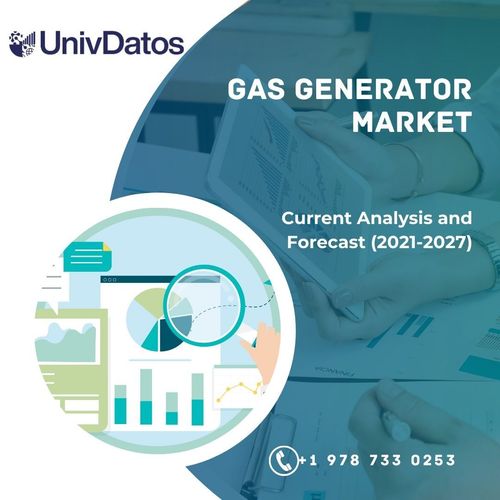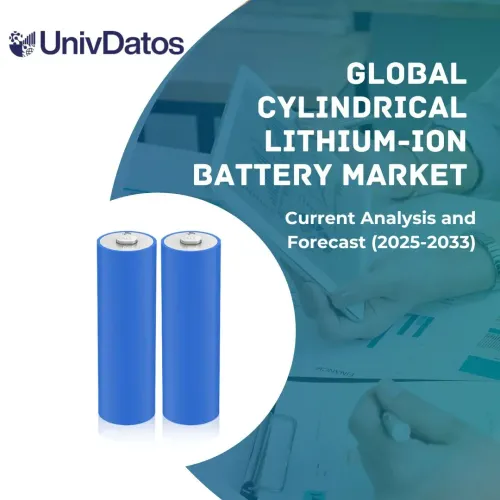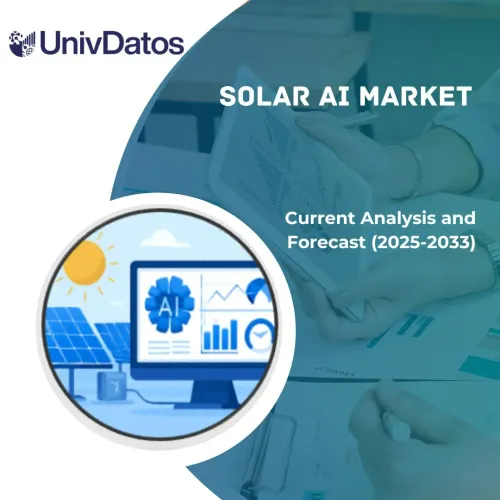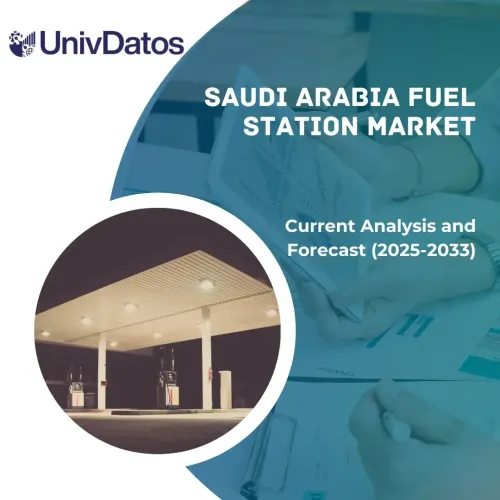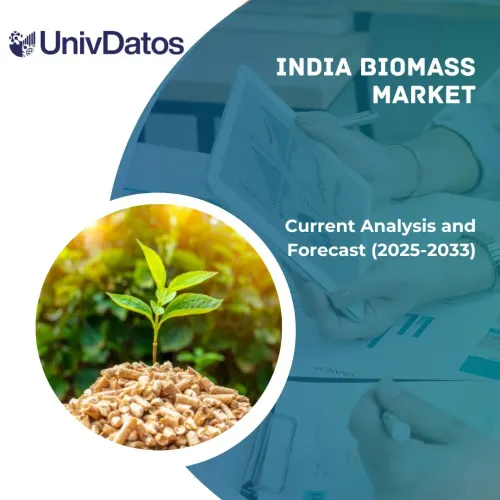- Home
- About Us
- Industry
- Services
- Reading
- Contact Us
India Green Hydrogen Market: Current Analysis and Forecast (2024-2032)
Emphasis on Electrolyzer (Proton Exchange Membrane Electrolyzer, Alkaline Electrolyzer, Others); Source (Solar Energy, Wind Energy, Others); End-User (Refining, Ammonia, Others); and State
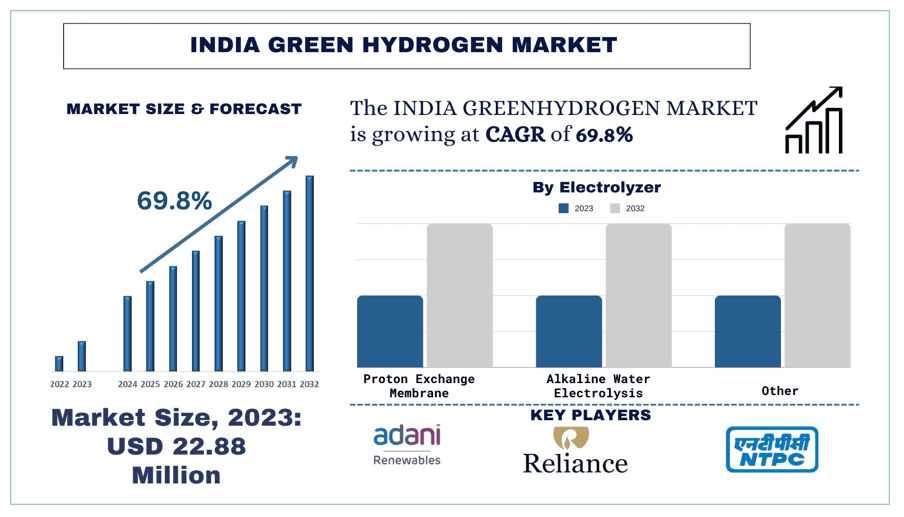
India Green Hydrogen Market Size & Forecast
The India green hydrogen market was valued at USD 22.88 Million in 2023 and is expected to grow at a strong CAGR of around 69.8% during the forecast period (2024-2032). This is mainly owing to the development of green hydrogen which has emerged as a priority for multilateral institutions and private funders.
India Green Hydrogen Market Analysis
India is currently the world’s third-largest economy in terms of energy consumption, and the country’s demand for energy is projected to increase by 35% by 2030. However, India has also committed to achieving net zero emissions by 2070, as announced at the United Nations Climate Change Conference in Glasgow (COP26) in 2021. To meet its energy needs while reducing emissions in hard-to-abate sectors on the path to net zero, green hydrogen is critical. To support green hydrogen production and consumption, the Indian government launched the National Green Hydrogen Mission in early 2022, which will provide roughly $2.3 billion in incentive funding between 2022 and 2030. Currently, India produces 6.5 million metric tonnes per annum (MMTPA) of hydrogen, mostly for use in crude oil refineries and fertilizer production. In addition, various key players in hydrogen and its derivatives production investing in the development of green hydrogen infrastructure are accelerating the demand for green hydrogen in the country.
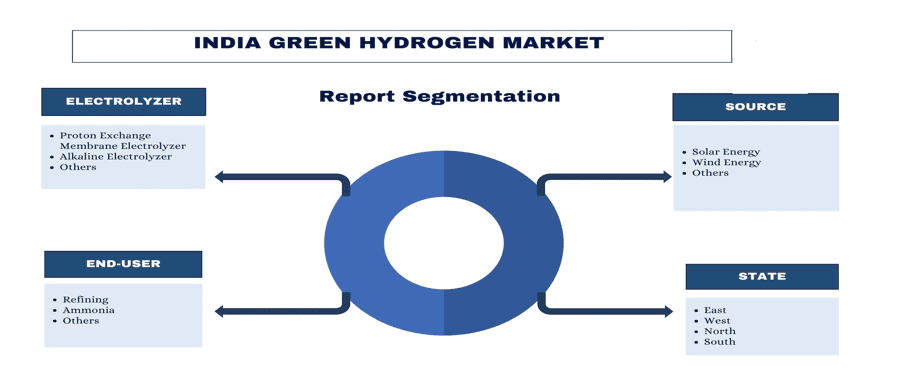
India Green Hydrogen Market Trends
Growing Hydrogen Infrastructure Development in India.
- The Indian government has recognized the potential of green hydrogen in contributing to the country’s energy security and decarbonization goals. In response, it has launched several initiatives and policies to foster growth in this sector. One of the most significant steps is the National Hydrogen Mission, announced in 2021, which aims to scale up the production of hydrogen and make India a global hub for green hydrogen production and export. This mission includes targets for generating green hydrogen and establishing standards for its production, storage, and distribution.
- Infrastructure development is a key aspect of this initiative. The government is supporting the construction of facilities for large-scale hydrogen production, particularly through partnerships with private and public sector enterprises. Major Indian corporations, including energy companies and conglomerates, have committed to investing in green hydrogen projects, signaling strong industry support.
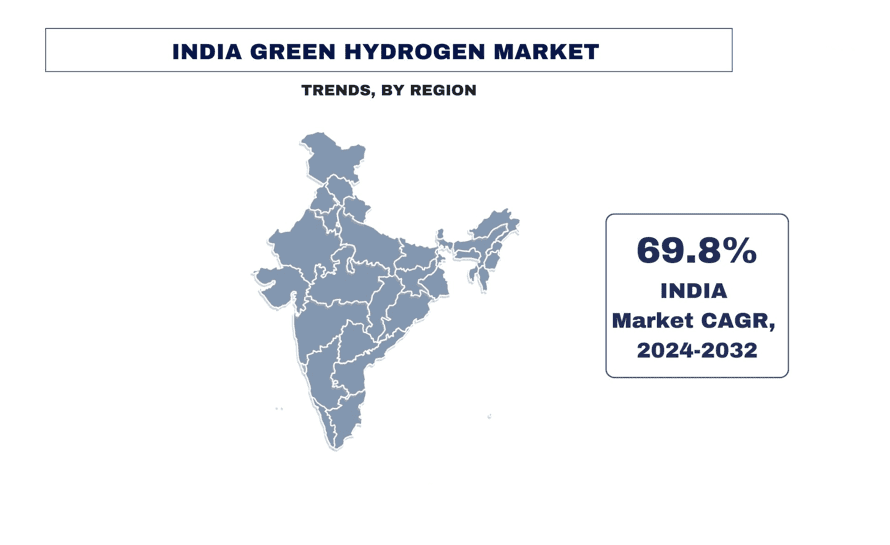
India Green Hydrogen Market Opportunities
Transitioning to hydrogen-fuelled vehicles:
- Transitioning to hydrogen-fueled vehicles, particularly buses, trucks, and commercial fleets, could dramatically reduce greenhouse gas emissions in the urban transport sector. Several Indian cities struggle with severe air pollution, and shifting public and commercial transport to hydrogen could improve air quality significantly. Furthermore, hydrogen fuel cells offer advantages over battery-electric vehicles, such as faster refueling times and longer range, which are critical for the viability of commercial transport.
- The government’s National Hydrogen Mission underscores this by aiming to develop hydrogen fuel cell technology in India and deploying pilot projects for hydrogen-powered buses and cars. Moreover, strategic partnerships and collaborations with global technology leaders and investors can accelerate the development and adoption of hydrogen technology, creating a robust supply chain and infrastructure.
West India is Expected to Grow with Significant CAGR During Forecast Period
The key player in the western state of India is further accelerating green hydrogen development in the country. Currently, Reliance industries is developing a significant green hydrogen project in Gujarat, reflecting a substantial commitment to the green energy sector, and contributing to India’s broader strategy for a cleaner and more sustainable future. These developments are critical as they place RIL among the top innovators reshaping the clean hydrogen landscape in the Asia-Pacific region, demonstrating a robust plan to advance the hydrogen economy and support India’s drive toward achieving carbon neutrality. Similarly, in 2023, Adani Group had invested $2.5 billion in developing a backward integrated value chain for its green hydrogen project and is on track to implement the first phase of the project with an annual capacity of 1 million tons by FY27
India Green Hydrogen Industry Overview
The green hydrogen market is competitive and fragmented, with the presence of several Indian and international market players. The key players are adopting different growth strategies to enhance their market presence, such as partnerships, agreements, collaborations, new product launches, geographical expansions, and mergers and acquisitions. Some of the major players operating in the market are Adani Green Energy Ltd, Reliance Industries, NTPC Ltd, Gail (India) Ltd, Oil and Natural Gas Corporation Ltd (ONGC), Larsen and Turbo, ACME Group, BHEL, Torrent Power, and Hygenco.
India Green Hydrogen Market report Coverage
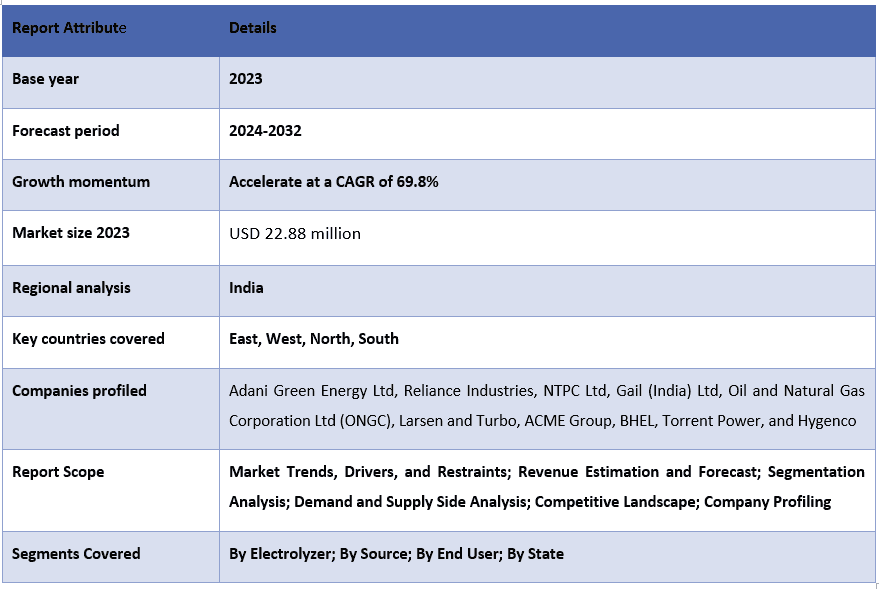
India Green Hydrogen Market News
- In 2024 NTPC arm NGEL has signed an agreement with the government of Andhra Pradesh for the development of an integrated green hydrogen hu
- In March 2024, India’s GAIL is set to commission the first green hydrogen project at the Vijaipur complex, Madhya Pradesh.
Reasons to buy this report:
- The study includes market sizing and forecasting analysis validated by authenticated key industry experts.
- The report presents a quick review of overall industry performance at one glance.
- The report covers an in-depth analysis of prominent industry peers with a primary focus on key business financials, product portfolios, expansion strategies, and recent developments.
- Detailed examination of drivers, restraints, key trends, and opportunities prevailing in the industry.
- The study comprehensively covers the market across different segments.
- Deep dive regional level analysis of the industry.
Customization Options:
The India green hydrogen market can further be customized as per the requirement or any other market segment. Besides this, UMI understands that you may have your own business needs, hence feel free to contact us to get a report that completely suits your requirements.
Table of Content
Research Methodology for the India Green Hydrogen Market Analysis (2024-2032)
Analyzing the historical market, estimating the current market, and forecasting the future market of the Indian green hydrogen market were the three major steps undertaken to create and analyze the adoption of green hydrogen in major countries in India. Exhaustive secondary research was conducted to collect the historical market numbers and estimate the current market size. Secondly, to validate these insights, numerous findings and assumptions were taken into consideration. Moreover, exhaustive primary interviews were also conducted, with industry experts across the value chain of the Indian green hydrogen market. Post assumption and validation of market numbers through primary interviews, we employed a top-down/bottom-up approach to forecasting the complete market size. Thereafter, market breakdown and data triangulation methods were adopted to estimate and analyze the market size of segments and sub-segments of the industry pertains to. Detailed methodology is explained below:
Analysis of Historical Market Size
Step 1: In-Depth Study of Secondary Sources:
A detailed secondary study was conducted to obtain the historical market size of the green hydrogen market through company internal sources such as annual reports & financial statements, performance presentations, press releases, etc., and external sources including journals, news & articles, government publications, competitor publications, sector reports, third-party database, and other credible publications.
Step 2: Market Segmentation:
After obtaining the historical market size of the green hydrogen market, we conducted a detailed secondary analysis to gather historical market insights and share for different segments & sub-segments for major regions. Major segments are included in the report as electrolyzer, source, and end-user. Further country-level analyses were conducted to evaluate the overall adoption of testing models in that region.
Step 3: Factor Analysis:
After acquiring the historical market size of different segments and sub-segments, we conducted a detailed factor analysis to estimate the current market size of the green hydrogen market. Further, we conducted factor analysis using dependent and independent variables such as electrolyzer, source, and end-user of the green hydrogen market. A thorough analysis was conducted for demand and supply-side scenarios considering top partnerships, mergers and acquisitions, business expansion, and product launches in the green hydrogen market sector across the globe.
Current Market Size Estimate & Forecast
Current Market Sizing: Based on actionable insights from the above 3 steps, we arrived at the current market size, key players in the India green hydrogen market, and market shares of the segments. All the required percentage shares split, and market breakdowns were determined using the above-mentioned secondary approach and were verified through primary interviews.
Estimation & Forecasting: For market estimation and forecast, weights were assigned to different factors including drivers & trends, restraints, and opportunities available for the stakeholders. After analyzing these factors, relevant forecasting techniques i.e., the top-down/bottom-up approach were applied to arrive at the market forecast for 2032 for different segments and sub-segments across the major markets in India. The research methodology adopted to estimate the market size encompasses:
- The industry’s market size, in terms of revenue (USD) and the adoption rate of the green hydrogen market across the major markets domestically
- All percentage shares, splits, and breakdowns of market segments and sub-segments
- Key players in the India green hydrogen market in terms of products offered. Also, the growth strategies adopted by these players to compete in the fast-growing market
Market Size and Share Validation
Primary Research: In-depth interviews were conducted with the Key Opinion Leaders (KOLs) including Top Level Executives (CXO/VPs, Sales Head, Marketing Head, Operational Head, Regional Head, Country Head, etc.) across major regions. Primary research findings were then summarized, and statistical analysis was performed to prove the stated hypothesis. Inputs from primary research were consolidated with secondary findings, hence turning information into actionable insights.
Split of Primary Participants in Different Regions
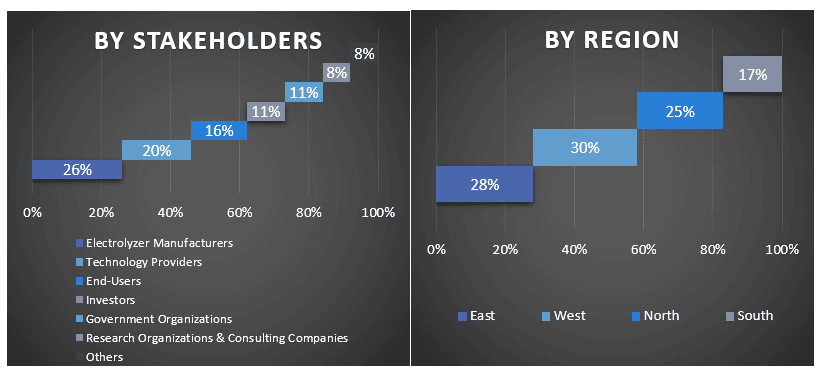
Market Engineering
The data triangulation technique was employed to complete the overall market estimation and to arrive at precise statistical numbers for each segment and sub-segment of the India green hydrogen market. data was split into several segments & sub-segments after studying various parameters and trends in the areas of the electrolyzer, source, and end-user in the India green hydrogen market.
The main objective of the India Green Hydrogen Market Study
The current & future market trends of the India green hydrogen market were pinpointed in the study. Investors can gain strategic insights to base their discretion for investments on the qualitative and quantitative analysis performed in the study. Current and future market trends determined the overall attractiveness of the market at a regional level, providing a platform for the industrial participant to exploit the untapped market to benefit from a first-mover advantage. Other quantitative goals of the studies include:
- Analyze the current and forecast market size of the green hydrogen market in terms of value (USD). Also, analyze the current and forecast market size of different segments and sub-segments
- Segments in the study include areas of the electrolyzer, source, and end-user
- Define and analyze the regulatory framework for the green hydrogen industry
- Analyze the value chain involved with the presence of various intermediaries, along with analyzing customer and competitor behaviors of the industry
- Analyze the current and forecast market size of the green hydrogen market for the major countries.
- Major countries of regions studied in the report include East, West, North, and South.
- Company profiles of the green hydrogen market and the growth strategies adopted by the market players to sustain in the fast-growing market
- Deep dive regional level analysis of the industry
Frequently Asked Questions FAQs
Q1: What is the current market size and growth potential of the India green hydrogen market?
Q2: What are the driving factors for the growth of the green hydrogen market?
Q3: Which segment has the largest share of the green hydrogen market by Electrolyzer?
Q4: What are the emerging technologies and trends in the green hydrogen market?
Q5: Which State will dominate the Indian green hydrogen market?
Related Reports
Customers who bought this item also bought

